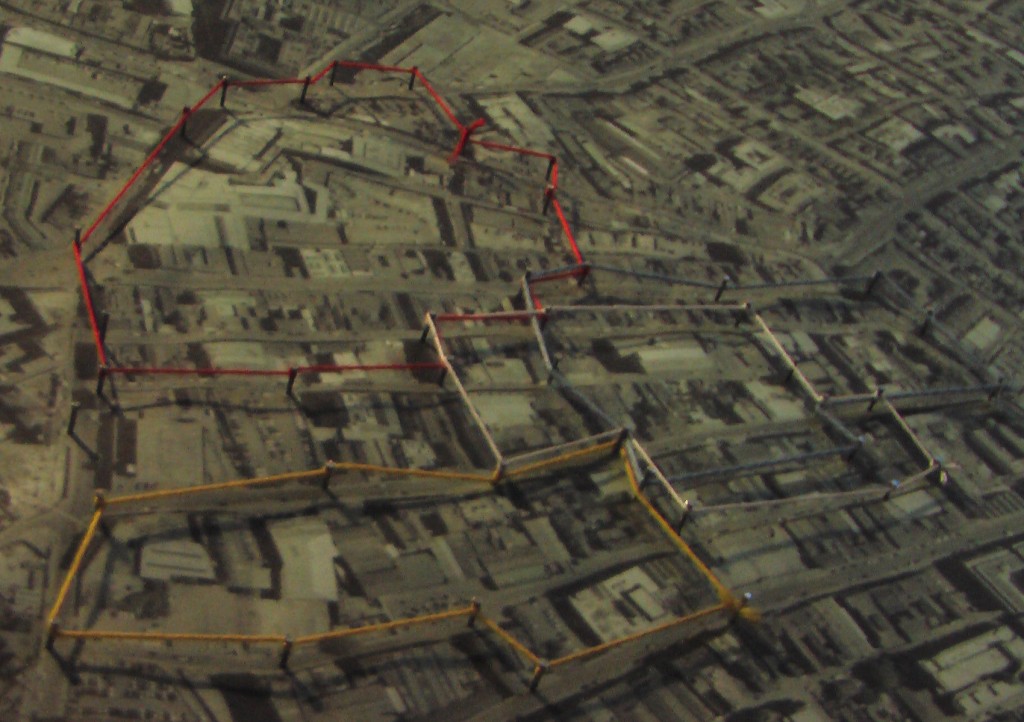
Line of sight was first enacted in March 2008 as part of Paradise Stories, an exhibition commissioned by Liverpool Capital of Culture. At a given time a line of sight is quietly drawn through the city. Strangers are connected together for a brief moment of silent solidarity, a message that is intimately passed from eye to eye.
Line of sight in Liverpool
A summary of events
Artist: Kaspar Wimberley
Supporting Artists: Rebecca Knight, Laura Lomax, Miriam Davies, Libby Bower
Line of sight was enacted three times in Liverpool with a total of 60 participants, while hundreds of people were approached on the streets and in the gallery space. Over the course of four days we encountered varying degrees of success, failure and successful failure.
The impact of such a project is impossible to measure. Not only is it impossible to know if everybody turned up and how they had each experienced the event, it is also impossible to know what effect you may have had on those who didn’t turn up. The feedback we received was mixed. Some participants found a focus, togetherness and the time to stop and catch breath, while others felt lonely after the event had come to an end. It was nice to receive an email from somebody who took part with a beautiful account of how they had experienced the event.
There were also highlights when things didn’t quite work out as intended. The moment two people had to look at one another through a police horse’s testicles, or when the two German ‘Walzer’ (a tradition involving travelling craftsmen from Germany →) went on to stay with us overnight.
From a purely subjective point of view, here are some of the things I liked about Line of Sight’s first outing:
I liked the mix of people who took part in each enactment, or were engaged on the streets as we searched for willing participants. I learnt to like the failure, when people didn’t turn up to take part, resulting in a broken circle and pockets of knowledge that the line of sight had not traveled continuously through the city. Maybe our absentees will find the crumpled instructions in their back pocket next day and spare a fresh thought on what might have taken place, why a stranger had asked them to take part and why they had agreed.
But what I liked most about the project was probably the stillness, as the rushing crowds or rushing thoughts slowly blended out of focus. Each enactment seemed to share an unusual mix of briefness and suspense, with muddled endings that didn’t quite know when to end (sometimes people held their gaze for longer than 5 minutes, not knowing how to negotiate an end and break the unspoken contact with one another).
The red helium balloons we gave to participants on the second day certainly helped everybody find one another, and possibly served as a constant reminder of what was to take place. This was the only day in which a complete line of sight may have been achieved. I don’t know what effect the balloons had on the passing crowds, though it seemed as though they hardly noticed, the event still taking place very much in the background.
It remains important that this project continues to take place between strangers, and that people converge into their allocated positions, rather than migrate from a shared ‘meeting point’. The attempted ‘Line of sight’ created at the opening event of paradise stories was a good example of an inappropriate setting that would never function as intended.
Documentation
I didn’t want to photograph the event as it took place, this would intrude on what was taking place and turn it into a spectator event. These photos can be easily staged at a later date. Each participant received a postcard and my contact details to send me feedback but the question about how to document and present the event at the gallery remained open to debate. Artist Laurel Kurtz suggested photographing each participant when they agree to take part, a small archive of those who would briefly be linked with one another. I might try this next time the project takes place, but photograph only a small part of the body to maintain a degree of anonymity.
The gallery presence in Liverpool (Planning HQ) consisted of a large map of Liverpool with each ‘Line of Sight’ marked out onto the surface. Exhibiting artist Faye floated the idea that, within the gallery, it might be sufficient that people simply believe that the event is taking place. You could create fictional routes and fictional forms of documentation to exaggerate the myth.
I would still like and develop the project to take place from within private spaces, balcony to balcony or window to window. To me this still adds an extra dimension that cuts through existing boundaries and notions of community and privacy, to stretch our focus to a point usually outside the perimeters of our living-environment or personal space. I also questioned at times if there were too many rules involved, though I can imagine in other cultures this might not be an issue. I look forward to conducting the experiment in Germany in the near future.
Thanks to everybody who did or didn’t take part,
Kaspar

